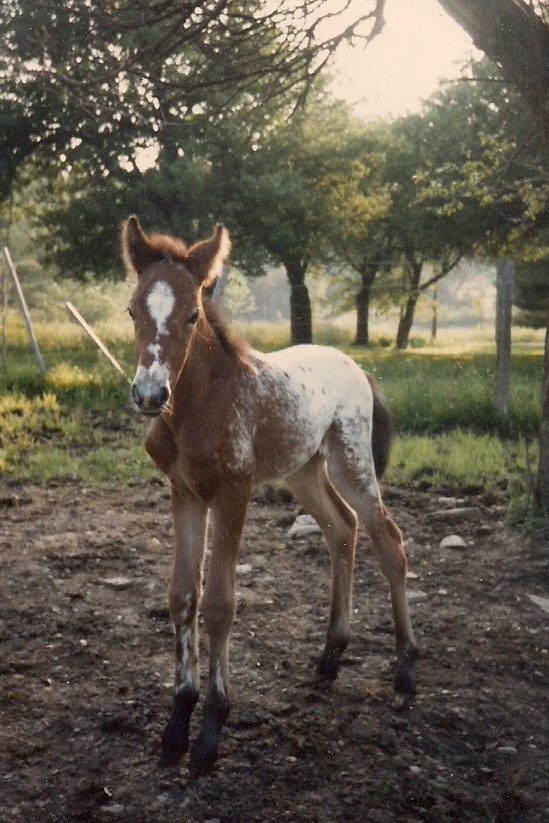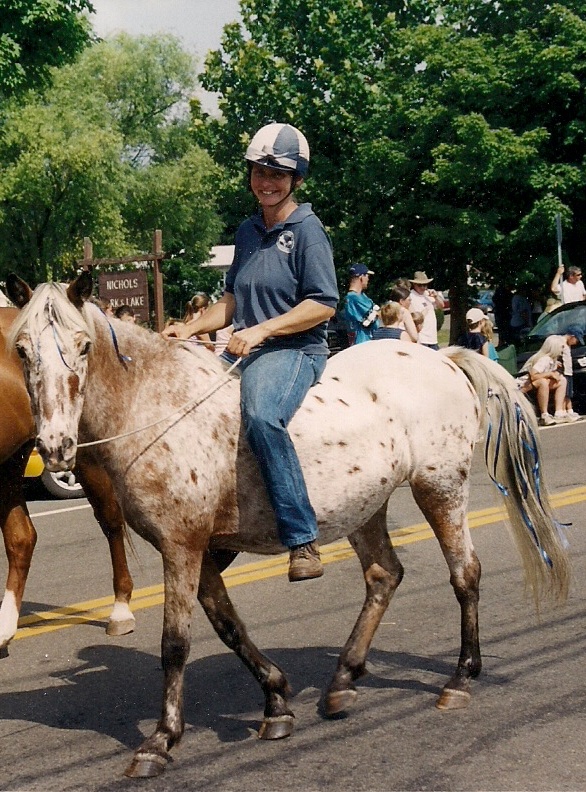
 It was hard to call the vet, hard to call the backhoe guy. I've put down more than a few horses, helped others with the euthanasia and burials. But this was Rindle.
It was hard to call the vet, hard to call the backhoe guy. I've put down more than a few horses, helped others with the euthanasia and burials. But this was Rindle.
Rindle was the daughter of the red road appaloosa mare I brought to upstate NY with me from Massachusetts in 1982 when I was twenty, the mare I rode bareback, sometimes with only a piece of twine around her neck.

Her sire was the cute-as-a-button pony colt I got for forty bucks at an auction, a hellion disguised as a rocking horse. This was Rindle's breeding: by Clever Opportunist out of Sanity.

Her sire was the cute-as-a-button pony colt I got for forty bucks at an auction, a hellion disguised as a rocking horse. This was Rindle's breeding: by Clever Opportunist out of Sanity.
Rindle was foaled in 1984 when I was an impossibly young twenty-two, about to begin work as an exercise rider, about to marry a dairy farmer, and years away from the birth of my human fillies.
She never grew past thirteen hands. It made her big enough for me to ride but too small for me to compete and possibly overwhelm with my overeager competitive nature that lasted into my thirties (riding her taller full brother.) Instead I rode Rindle on trails, in hunter paces, and led daughters or lessons from her. She taught dozens of kids to ride, sailed over Pony Club jumps, loped around 4H rings and marched down Main Street in the Spencer Picnic parade.

 She was a master of the center-of-the-ring shoulder drop, a classic staple of lesson ponies. (She pulled this on me when I was demonstrating a canter transition and I hit the ground so hard I sprained my ankle. That was only ten years ago.) In a wild and wonderful hunter pace, Rindle and I, with my nine-year-old daughter and her pony, Cupcake, rode a blistering round over the jumps to catch up with our friends on horses. Our friends cam in first; we were penalized to second place for going too fast.
She was a master of the center-of-the-ring shoulder drop, a classic staple of lesson ponies. (She pulled this on me when I was demonstrating a canter transition and I hit the ground so hard I sprained my ankle. That was only ten years ago.) In a wild and wonderful hunter pace, Rindle and I, with my nine-year-old daughter and her pony, Cupcake, rode a blistering round over the jumps to catch up with our friends on horses. Our friends cam in first; we were penalized to second place for going too fast.
She never grew past thirteen hands. It made her big enough for me to ride but too small for me to compete and possibly overwhelm with my overeager competitive nature that lasted into my thirties (riding her taller full brother.) Instead I rode Rindle on trails, in hunter paces, and led daughters or lessons from her. She taught dozens of kids to ride, sailed over Pony Club jumps, loped around 4H rings and marched down Main Street in the Spencer Picnic parade.

 She was a master of the center-of-the-ring shoulder drop, a classic staple of lesson ponies. (She pulled this on me when I was demonstrating a canter transition and I hit the ground so hard I sprained my ankle. That was only ten years ago.) In a wild and wonderful hunter pace, Rindle and I, with my nine-year-old daughter and her pony, Cupcake, rode a blistering round over the jumps to catch up with our friends on horses. Our friends cam in first; we were penalized to second place for going too fast.
She was a master of the center-of-the-ring shoulder drop, a classic staple of lesson ponies. (She pulled this on me when I was demonstrating a canter transition and I hit the ground so hard I sprained my ankle. That was only ten years ago.) In a wild and wonderful hunter pace, Rindle and I, with my nine-year-old daughter and her pony, Cupcake, rode a blistering round over the jumps to catch up with our friends on horses. Our friends cam in first; we were penalized to second place for going too fast.
Rindle's last day was mild and sunny. She spent it grazing with her best horse friend, my mare Laredo. All week, snippets of a poem had run through my head: Lord Byron, quoted by Ray Bradbury in a short story I read back in my pony girl days:
So, we'll go no more a roving,
Though the heart be still as loving,
And the moon be still as bright.
For the sword outwears its sheath,
And the soul wears out the breast,
And the heart must pause to breathe,
And love itself have rest.
Though the night was made for loving,
And the day returns too soon,
Yet we'll go no more a roving
By the light of the moon.
 I was raised in Christian Science, where death and mortality are "unreal." I floundered through the deaths of pets, but I never had to contend with losing a relative until I was an adult, and by then well-trained to freeze my emotions. It's fair to say that Rindle's loss was the first death I faced head on as a human being. I raised her and knew her for twenty-nine years. She was a family member.
I was raised in Christian Science, where death and mortality are "unreal." I floundered through the deaths of pets, but I never had to contend with losing a relative until I was an adult, and by then well-trained to freeze my emotions. It's fair to say that Rindle's loss was the first death I faced head on as a human being. I raised her and knew her for twenty-nine years. She was a family member.
I stayed with her as she breathed the last time. I bawled like a baby. I clipped hair from her mane and tail. My friends saw to her burial while I loaded Laredo for the ride to a farm six miles away where I board her now. Where I'm riding again after a five year hiatus. I owe this to Rindle.
I kept Rindle's photos as my desktop computer wallpaper for the whole year. I think about her every single day. I miss her, and I let myself feel this hurt. She's taught me to grieve. I'm glad her transition out of life was as smooth as the one into it, both in a meadow in clear, warm weather. I'll always remember riding her at night, July or January, with crickets or the crunch of hoofs on snow, by the full moon.
Miss you, Rindle-kid.











